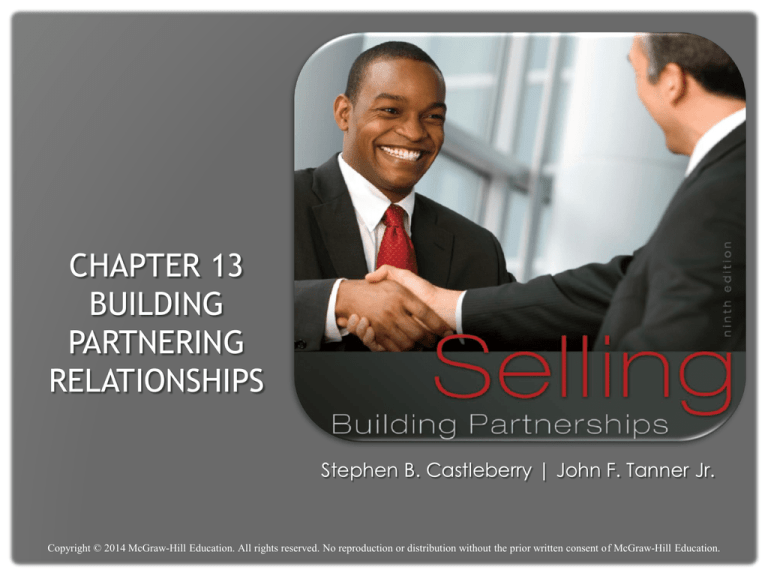
CHAPTER 13
BUILDING
PARTNERING
RELATIONSHIPS
Stephen B. Castleberry | John F. Tanner Jr.
Copyright © 2014 McGraw-Hill Education. All rights reserved. No reproduction or distribution without the prior written consent of McGraw-Hill Education.
LEARNING OBJECTIVES
• What different types of relationships exist between
buyers and sellers?
• When is each type of relationship appropriate?
• What are the characteristics of successful partnerships?
13-2
LEARNING OBJECTIVES
• What are the benefits and risks in partnering
relationships?
• How do relationships develop over time?
• What are the responsibilities of salespeople in
partnerships?
13-3
THE VALUE OF CUSTOMERS
• Strong relationships with customers are a source of
competitive advantage
• Customer lifetime value (CLV): Combined total of all
future sales
• Successfully retaining customers is important to all
companies
13-4
RELATIONSHIPS AND SELLING
• Relationship marketing - Companies’ attempts to
develop stronger relationships with their customers
• Accomplished through building loyalty
• Behavioral loyalty: Purchase of the same product from
the same vendor over time
• Attitudinal loyalty: Emotional attachment to a brand,
company, or salesperson
13-5
TYPES OF RELATIONSHIPS
• Market Exchanges: Transaction between a buyer and a
seller in which each party is concerned only about its
own benefit
• Solo exchanges: Both the buyer and the seller pursue their
own self-interests
• No future business
• Functional relationships: Long-term market exchanges
characterized by behavioral loyalty
• Customer satisfaction: Buyer’s expectations are met and
needs are fulfilled
13-6
EXHIBIT 13.2 - TYPES OF RELATIONSHIPS
BETWEEN BUYERS AND SELLERS
13-7
PARTNERSHIPS
• Win-win relationship: Both parties are concerned
about each other’s welfare
• Types
• Relational partnerships
• Strategic partnerships
13-8
PARTNERSHIPS
Relational partnerships
• Buyer and seller have a close personal relationship
• Marked by open, and honest communication
• Partners trust each other and worry about small details
• Not necessarily strategic but provides flexibility
Strategic partnerships
• Long-term business relationships
• Partners make significant investments to improve the
profitability of both parties
• Partners have gone beyond trusting each other
• Partnerships get a strategic advantage
• Created for uncovering and exploiting joint opportunities
13-9
EXHIBIT 13.3 SELLING IN MARKET EXCHANGES AND
LONG-TERM RELATIONSHIPS
Source: Adapted from Thomas Ingram, “Relationship Selling: Moving from Rhetoric to Reality, Mid-American Journal of Business 11 (1996),
p. 6.
13-10
EXHIBIT 13.3 SELLING IN MARKET EXCHANGES AND
LONG-TERM RELATIONSHIPS
Source: Adapted from Thomas Ingram, “Relationship Selling: Moving from Rhetoric to Reality, Mid-American
Journal of Business 11 (1996), p. 6.
13-11
CHOOSING THE RIGHT RELATIONSHIP
• Factors to consider
• Type of relationship the customer desires
• Size of the account
• Access and image in the market
• Access to technology
13-12
USING TECHNOLOGY TO INCREASE
EFFICIENCY
• Technology drives following key areas of salesperson
performance
• Knowledge management technology: Helps salespeople
manage all the information required to be effective
• Relational management technology - Builds on customer
knowledge management systems to create models that can
be used to develop strategy
13-13
PHASES OF RELATIONSHIP DEVELOPMENT
Awareness
Exploration
Expansion
Commitment
Dissolution
13-14
AWARENESS
• Salespeople locate and qualify prospects
• Buyers identify various sources of supply
• Supplier relationship management (SRM): Use of
technology and statistics to identify important suppliers
and opportunities for:
• Cost reduction
• Greater efficiency
• Other benefits
13-15
EXPLORATION
• Search and trial phase for both buyer and seller
• Exploring potential benefits and costs of a partnership
• Satisfaction in this phase allows relationship to move
forward
• Dependability and competence are tested
13-16
EXPANSION
• Involves efforts by both parties to investigate the
benefits of a long-term relationship
• Both parties is to develop the appropriate type of
relationship
• Both parties probe regarding interest in a partnership
• Internal
• External
13-17
COMMITMENT
• Customer and seller implicitly or explicitly pledge to
continue the relationship for a period of time
• Most advanced stage of the relationship
• Investments are made at this stage
• Involves promises by buyer and seller to work over
many transactions
13-18
DISSOLUTION
• Process of terminating the relationship
• Can occur because of:
• Poor performance
• Clash in culture
• Change in needs
• Other factors
• Loss of investments impacts both organizations
13-19
EXHIBIT 13.4 - FOUNDATIONS OF
SUCCESSFUL RELATIONSHIPS
13-20
MUTUAL TRUST
• Trust: Belief by one party that the other party will
fulfill its obligations in a relationship
• Dependability: Perception that the salesperson, and the
product and company, will live up to promises made
• Can be proved by:
• Third-party references, product demonstrations and plant
tours
• Special presentations, salesperson’s experience and training
• Time
13-21
MUTUAL TRUST
• Competence: Demonstrated knowledge of:
• Customer
• Product
• Industry
• Competition
13-22
MUTUAL TRUST
• Customer orientation: Degree to which salesperson
puts customer needs first
• Stressing benefits and solutions to problems over features
• Emphasizing the salesperson’s availability and desire to
provide service
• Honesty: Truthfulness and sincerity
• Likeability: Behaving in a friendly manner and finding
a common ground between buyer and seller
• Requires increasing personal communication
13-23
OPEN COMMUNICATION
• Key building block for building successful relationships
• Different for relational and strategic partnership
• Relational partnership - Communication goes through the
salesperson
• Strategic partnership - Direct communication between the
buyer and seller
• Cultural differences should be considered
13-24
COMMON GOALS
• Provide strong incentive to pool strengths and abilities
• Help focus on exploiting opportunities
• Help sustain the partnership
• Effective measuring of goals is critical
13-25
COMMITMENT TO MUTUAL GAIN
• Creates a win-win relationship
• One does not take advantage of the other
• Mutual investment: Tangible investment in the
relationship by both parties
• Involves spending money to improve the products and
services
• Must be followed by actions signaling commitment
13-26
ORGANIZATIONAL SUPPORT
• Boundary spanning employees: Employees who cross
the organizational boundary and interact with customers
or vendors
• Should be given necessary support
• Structure and culture
• Training
• Rewards
13-27








